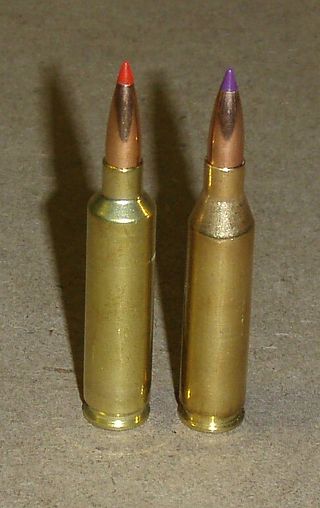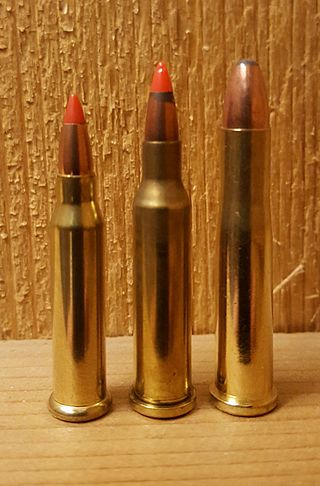
A cartridge, also known as a round, is a type of pre-assembled firearm ammunition packaging a projectile, a propellant substance and an ignition device (primer) within a metallic, paper, or plastic case that is precisely made to fit within the barrel chamber of a breechloading gun, for convenient transportation and handling during shooting. Although in popular usage the term "bullet" is often used to refer to a complete cartridge, the correct usage only refers to the projectile.

A rim-fire is a type of metallic cartridge used in firearms where the primer is located within a hollow circumferential rim protruding from the base of its casing. When fired, the gun's firing pin will strike and crush the rim against the edge of the barrel breech, sparking the primer compound within the rim, and in turn ignite the propellant within the case. Invented in 1845 by Louis-Nicolas Flobert, the first rimfire metallic cartridge was the .22 BB Cap cartridge, which consisted of a percussion cap with a bullet attached to the top. While many other different cartridge priming methods have been tried since the early 19th century, such as teat-fire and pinfire, only small caliber rimfire cartridges have survived to the present day with regular use. The .22 Long Rifle rimfire cartridge, introduced in 1887, is by far the most common ammunition found in the world today in terms of units manufactured and sold.

The Martini–Henry is a breech-loading single-shot rifle with a lever action that was used by the British Army. It first entered service in 1871, eventually replacing the Snider–Enfield, a muzzle-loader converted to the cartridge system. Martini–Henry variants were used throughout the British Empire for 47 years. It combined the dropping-block action first developed by Henry O. Peabody and improved by the Swiss designer Friedrich von Martini, combined with the polygonal rifling designed by Scotsman Alexander Henry.

The .223 Remington is a rimless, bottlenecked, centerfire intermediate cartridge. It was developed in 1957 by Remington Arms and Fairchild Industries for the U.S. Continental Army Command of the United States Army as part of a project to create a small-caliber, high-velocity firearm. The .223 Remington is considered one of the most popular common-use cartridges and is used by a wide range of semi-automatic and manual-action rifles.

The .32-20 Winchester / 7.94x33mmR, also known as .32 WCF , was the first small-game lever-action intermediate cartridge that Winchester produced. It was initially introduced as a black-powder cartridge in 1882 for small-game, varmint hunting, and deer. Colt produced a single-action revolver chambered for this cartridge a few years later.

A wildcat cartridge, often shortened to wildcat, is a custom-made cartridge for which ammunition and/or firearms are not mass-produced. These cartridges are often created as experimental variants to optimize a certain ballistic performance characteristic of an existing commercial cartridge, or may merely be intended as novelty items.
A rim is an external flange that is machined, cast, molded, stamped, or pressed around the bottom of a firearms cartridge. Thus, rimmed cartridges are sometimes called "flanged" cartridges. Almost all cartridges feature an extractor or headspacing rim, in spite of the fact that some cartridges are known as "rimless cartridges". The rim may serve a number of purposes, including providing a lip for the extractor to engage, and sometimes serving to headspace the cartridge.

The .577/450 Martini–Henry is a black powder, centrefire rifle cartridge. It was the standard British service cartridge from the early 1870s that went through two changes from the original brass foil wrapped case to the drawn brass of two parts, the case and the primer. The .577/450 Martini–Henry was introduced with the Martini–Henry, in service it succeeded the .577 Snider cartridge and was used by all arms of the British armed forces as well British colonial forces throughout the British Empire until it was itself succeeded by the .303 British cartridge after an unsuccessful trial of a .402 calibre.

The .17 Hornet / 4.4x34mmR is a .17 caliber centerfire rifle cartridge originally offered as a "wildcat cartridge" developed by P.O. Ackley in the early 1950s. He created this non-factory (wildcat) offering by simply necking-down the .22 Hornet to .17 caliber and fire-forming the resized cases in his new chamber design. The result was a small quiet cartridge capable of high velocity. Ackley mentions it as one of the most balanced of the .17 cartridges of his time; likely, this is still true.

The .225 Winchester / 5.7x49mm cartridge was introduced in 1964 by the Winchester Repeating Arms Company.

The 5.6×50mm Magnum is a centerfire, rimless, bottlenecked rifle cartridge that was developed in 1970 by Günter Frères of the Deutsche Waffen und Munitionsfabriken (DWM).

The .303 Savage is a rimmed, .30 caliber rifle cartridge developed by the Savage Arms Company in 1894 which was designed as a short action cartridge for their Savage Model 1895 later 1899 hammerless lever-action rifle. The cartridge was designed for smokeless powder at a time when black-powder cartridges were still popular. The .303 Savage round was ballistically superior to the .30-30, but only marginally. The .303 Savage remained popular through the 1930s. Savage produced a half dozen loads for it. With its 190-grain loading, it was used on such animals as deer and moose.
The .260 Remington cartridge was introduced by Remington in 1997. Many wildcat cartridges based on the .308 Winchester case had existed for years before Remington standardized this round.

The .416 Remington Magnum is a .416 caliber (10.57 mm) cartridge of belted bottlenecked design. The cartridge was intended as a dangerous game hunting cartridge and released to the public in 1989. The cartridge uses the case of the 8 mm Remington Magnum as a parent cartridge. When the cartridge was released in 1988, author Frank C. Barnes considered the .416 Remington Magnum to be the "most outstanding factory cartridge introduced in decades".

The .310 Cadet, also known as the .310 Greener, or the .310 Martini, is a centerfire rifle cartridge, introduced in 1900 by W.W. Greener as a target round for the Martini Cadet rifle. Firing a 120 grain heeled lead projectile at 1350 ft/s the round is similar in performance to the .32-20 Winchester and some rifles may chamber both rounds with some accuracy. The full metal jacketed round was used in cadet rifles in Australia and New Zealand after early 20th-century Defence Acts. In New Zealand, after the start of the Boer War, a cadet corps had been started; by 1901 it was recommended that membership be compulsory. 500 Westley-Richards miniature Martini–Henry rifles were available by October 1902, and 5000 by April 1903 (Star). Such rifles gained popularity in Australia, New Zealand and the United States when thousands of Martini Cadet rifles were sold by the Australian government after World War II. A shorter version used as a humane killer was used in pistols. Known as the .310 cattle killer, invented by WW Greener, it was shorter in that a .310 cadet could not be accidentally chambered into the humane killer pistol.

The .303/25, sometimes known as the .25/303 is a wildcat centrefire rifle cartridge, based on the .303 British, necked down to fire a .257 projectile, originating in Australia in the 1940s as a cartridge for sporterised rifles, particularly on the Lee–Enfield action; similar versions also appeared in Canada around the same time.
The .303/22, sometimes known as the .22/303, is a wildcat centrefire rifle cartridge based on the .303 British, necked down to fire a .224 projectile, originating in Australia in the 1930s as a cartridge for sporterised rifles, particularly on the Lee–Enfield action. Similar versions also appeared in Canada around the same time.

The .22 Spitfire is an American wildcat rifle cartridge developed by Col. Melvin M. Johnson. It was originally named the MMJ 5.7mm by its designer and is also known in the U.S. as the 5.7mm Johnson, the Johnson MMJ 5.7mm Spitfire, and the .22 Johnson,.

The .38-55 Winchester / 9.6x53mmR cartridge, also known as the .38-55 WCF and the .38-55 Ballard, is a centerfire rifle cartridge. It was based on an earlier cartridge called the .38-50 Ballard Everlasting that was introduced in 1876 by the Ballard Rifle & Cartridge Company. The .38-55 Ballard was originally a Black-powder cartridge as used in Ballard and Marlin Firearms from 1876 onwards for various single-shot target rifles. Their 1893 lever-action rifle was also available in 38-55 using a Black-powder only barrel, or another barrel designated "Special Smokeless Steel" capable of safely using 38-55 cartridges loaded with the then relatively new and higher pressure smokeless powders. It was later offered by Winchester in its Model 1894, who usurped the name calling it the 38-55 Winchester, although it was an exact dimensional copy of the 38-55 Ballard. Winchester continued to use the round in various rifles until about 1940, and also used it in a few commemorative editions of rifles since then. In addition, Marlin offered it in some 336s, and it was used in non-lever action rifles such as the Remington-Lee bolt-action. The .38-55 Winchester is also the parent case for the .30-30 Winchester, .32 Winchester Special, and the .375 Winchester cartridges.

The .219 Zipper / 5.7x49mmR cartridge was created by Winchester Repeating Arms in 1937 to be used in their lever-action Model 64 rifle. It is a 30-30 Winchester cartridge necked down to a .22 caliber bullet. Marlin Firearms also offered their Marlin Model 336 rifle chambered for the cartridge.


















